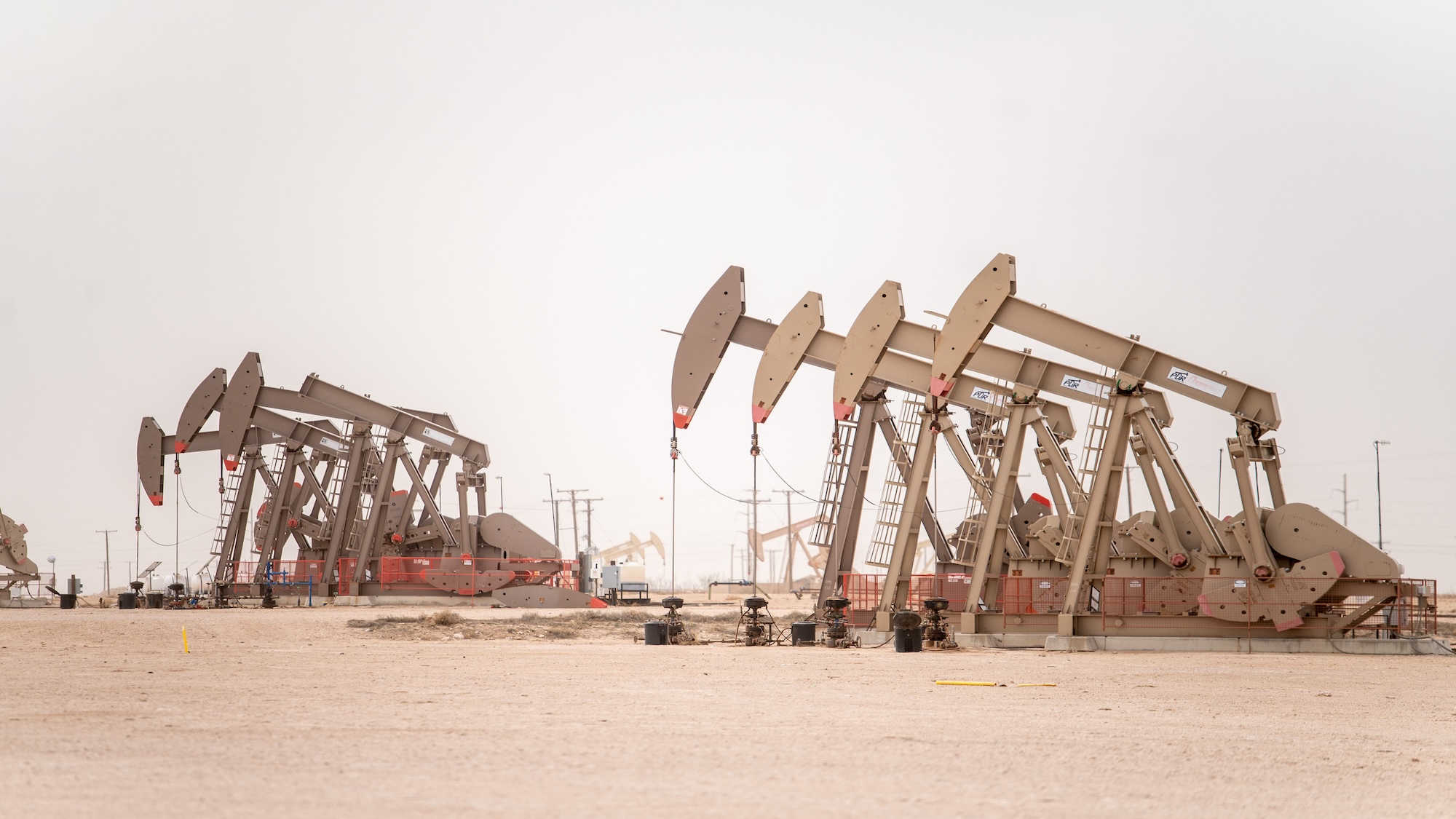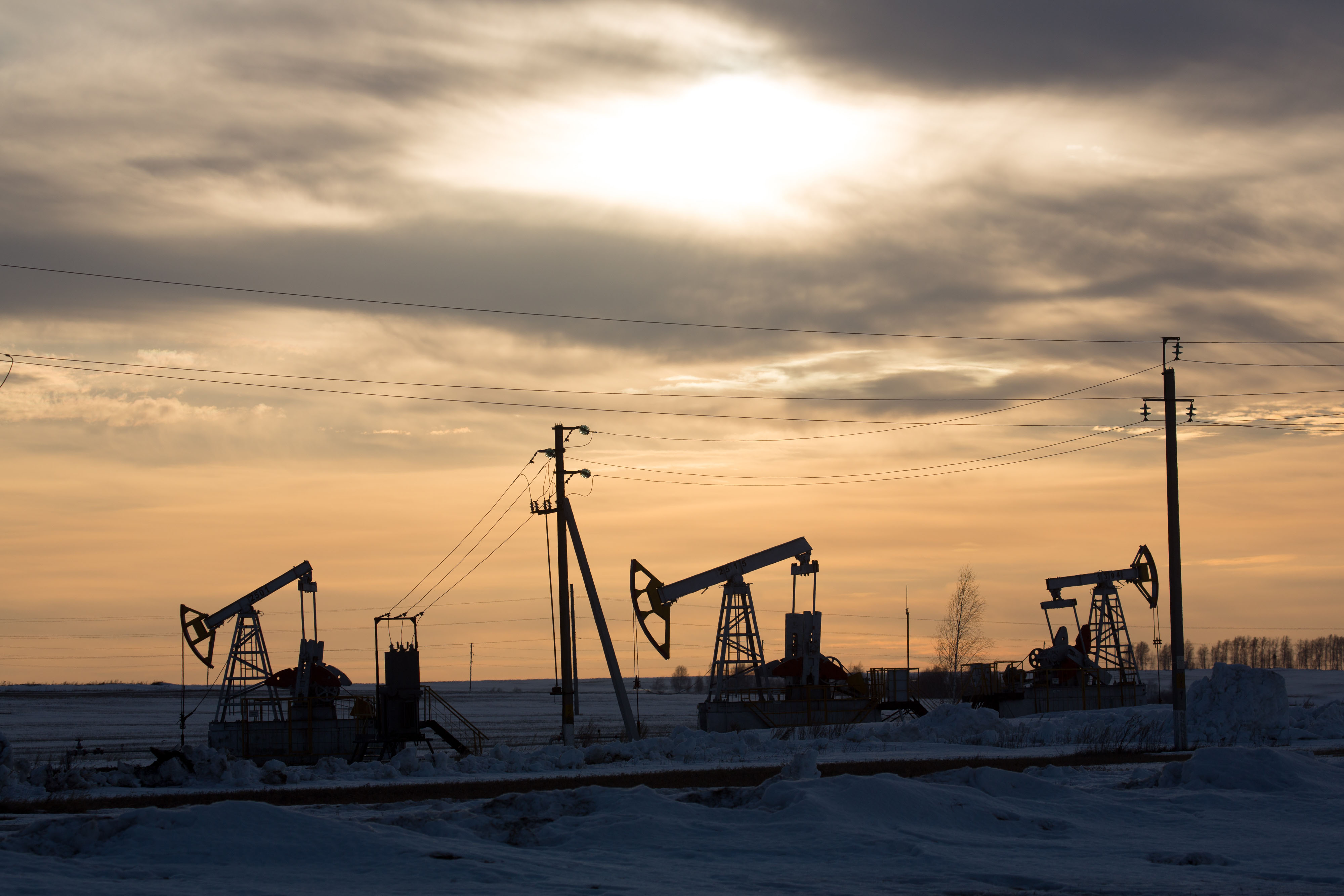Oil price posts two-year highs - but how long can it last?
Brent rose above $59 a barrel this week, its best third-quarter showing since 2004

Oil price could still be as low as $25 in a year's time
18 January
Oil prices fell sharply overnight and touched a near 13-year low as the US and EU prepared to lift international sanctions on dormant oil power Iran earlier than expected.
In a market already flooded with excess supply that has pushed onshore reserves to record levels and driven prices ever lower, Iranian exports ramping up – it has pledged to add 500,000 barrels a day immediately and a million within six months – is seen as an extremely bearish signal. International benchmark Brent crude fell to $27.70 overnight, its lowest level since 2003.
The Week
Escape your echo chamber. Get the facts behind the news, plus analysis from multiple perspectives.

Sign up for The Week's Free Newsletters
From our morning news briefing to a weekly Good News Newsletter, get the best of The Week delivered directly to your inbox.
From our morning news briefing to a weekly Good News Newsletter, get the best of The Week delivered directly to your inbox.
This process could begin very shortly and perhaps as soon as the end of this month. A United Nations agency tasked with overseeing Iran's compliance with its deal to curtail its nuclear programme, a precondition to removing sanctions, said yesterday the country had met all of the required terms.
Ric Spooner, chief market analyst at CMC Markets, told the BBC Iran has "quite a large storage of oil at the moment" and can "increase supply quite quickly". Some reckon it already has buyers lined up in Europe, where a fierce price war with regional rival Saudi Arabia, one of the biggest oil producers in the world, is beginning to take shape.
However, several analysts were arguing there might be a price rise on Monday in a "sell the rumour, buy the fact" move that would reflect the removal of uncertainty on Iran. Some others predicted prices would at least hold steady. "The Iran deal should not be a surprise to the market and has been expected for a long time," Amrita Sen, of consultancy Energy Aspects, said.
After the fall overnight, Brent crude had recovered around $1 per barrel to $28.60 in London this morning.
A free daily email with the biggest news stories of the day – and the best features from TheWeek.com
Ultimately, though, the oversupply issue still dominates. New exports will add to global supplies that are one to two million barrels a day in excess of consumption, at a time when demand could be hit by a slowing of the global economy and oil producers in the Middle East and elsewhere are in discord on policies to stop the slump.
This had led to predictions of a short-term fall to $25, $20 or even $10 a barrel and prices could remain at painful lows for longer.
HSBC chief executive Stuart Gulliver said he expected the price of oil in a year's time to have settled between a high of $40 and a low of $25 a barrel, well below currently predicted averages for the next 12 months.
Oil price: sell 'any and all rallies' as Iran prepares to pump
15 January
The oil price fell below $30 a barrel for the third consecutive day today, as yet another rally that had taken hold on Thursday fell away.
International benchmark Brent crude was modestly below $30 as it continued a slide that set in yesterday afternoon in New York and overnight in Asia. Earlier on Thursday, the price had risen to well in excess of $31, still low by historical standards but welcome relief from the bearish run, before the prevailing negative trend set back in.
The market is still gripped by oversupply. The US's primary crude oil facility, in Cushing, Oklahoma, is stuffed with a record stockpile of 64 million barrels, The Economist notes, while in other areas around the world - including, critically, China - storage facilities are so full that millions of barrels are floating offshore in tankers.
And then there is Iran.
The United Nations' international nuclear agency is expected to confirm on Monday that the republic has met the conditions of its deal struck with the US last year, says The Times. This will lead to the removal of sanctions inhibiting oil exports coming perhaps as early as the end of this month and as many as a further 500,000 to one million barrels a day flooding the market within six months.
Amid a breakdown in relations with its regional rival Saudi Arabia, the largest oil producer in the world, this is likely to undermine any hopes of a deal to limit excess output.
"We feel the Saudis will pump even more and a price war between them and the Iranians will drive us well into the $20 levels. We are sellers of any and all rallies in days and weeks to come," Tariq Zahir, at New York's Tyche Capital Advisors, told Reuters.
The one bright spot on the horizon is a slowing of production in Russia, another of the world's largest producers, which has also been fuelling an export war with Saudi Arabia. "The oil-pipeline monopoly Transneft said Russian companies are likely to cut crude shipments by 6.4 per cent over the course of 2016," writes Ambrose Evans-Pritchard in the Daily Telegraph.
As the journalist adds, the key question is "whether the production cuts are purely driven by markets or whether it is in part a political move to pave the way for a deal with Saudi Arabia".
Oil price falls below $30 with no end to slump in sight
14 January
The oil price trend has been volatile for several trading sessions, with strong intra-day rallies typically giving way to late sell-offs that are contributing to a steady, cumulative decline.
Unsurprisingly, it was new data that evidenced the stubborn global oil-supply glut that precipitated the latest slide. The international energy watchdog reported that output around the world grew by 200,000 last week, the Daily Telegraph notes, even as the market is already producing one to two million more barrels a day more than is being consumed.
The International Energy Agency also revealed Russian exports reached a post-Soviet era high last year. The country is one of several major producers around the world - including the de facto leader of the powerful Opec cartel Saudi Arabia - locked in an internecine battle for market share.
Elsewhere, the US energy watchdog said the country's reserves of oil derivative products surged last week. An 8.6 million barrel rise in stockpiles of petrol in particular added to a 10.6 million barrel lift the week before, constituting what CNBC describes as "an unheard of two-week build".
As important, the Energy Information Administration reported a second consecutive week of modest growth in shale oil output, taking overall US supply up to 9.23 million barrels a day. The production turf war was supposed to have clipped the wings of the sector and thus eventually prompted a rebalancing of the market.
All in all, the picture remains extremely bearish, especially when the political ructions in the Middle East, which will undermine any cohesive response to the glut, are factored in. Analysts have said prices will fall to $25, $20 or even as low as $10 a barrel in the coming months.
This will push petrol prices to ever lower levels in 2016, the RAC claims. If oil reaches $10, it expects the cheapest petrol in the UK to be sold for around 86p a litre, below the level of most supermarket bottled water.
Oil price slump: as BP cuts jobs, does North Sea oil have a future?
13 January
BP has announced plans to shed about 600 jobs from its operations in the North Sea, part of a new set of cutbacks that will see 4,000 staff go globally.
Blaming low oil prices, the company said it was taking the step in the face of "toughening market conditions", but added it remained committed to the North Sea.
So what does the news mean about the wider sector?
What is behind the move?
Oil prices have been hit by a combination of oversupply, weak global demand, Middle East unrest and the strong US dollar. Despite recovering from its latest slump yesterday and overnight, the international benchmark is near a 12-year low at $31.50 a barrel, a painfully unprofitable price for much North Sea production, where it costs an average of $50 to extract a barrel of oil.
This has had disastrous results for the sector, threatening an industry that employs more than 375,000 people and was, until recently, one of the richest sources of tax revenue for the Exchequer.
What are the current production levels in the North Sea
Despite "toughening market conditions", oil production in the UK Continental Shelf last year rose by 8 per cent on 2014, according to trade body Oil & Gas UK. This bucked a 15-year trend of falling oil and gas production in the North Sea, but Oil & Gas UK believes the news will do little to improve belief in the sector.
The increase is actually simply a function of investments made anywhere up to a decade ago, when prices were projected to be much higher. "The fact is, the value of our product has more than halved. Times are really tough for this industry and for the people working in it," said Deirdre Michie, chief executive of Oil & Gas UK.
How long will the increase last?
Brendan Warn, senior oil and gas analyst at BMO Capital Markets, said the increase in production was only a result of investment decisions taken years before prices plunged and that as they have fallen, investment in new wells has been withdrawn. This lag means "North Sea oil and gas production news headlines will be horrendous in the 2017-20 time period".
What does this mean for the future
Though BP says it remains committed to North Sea oil, companies are expected to drill just six exploration wells in the area this year, the lowest number since 1964, with the result that as decades-old fields run dry, there will be fewer new projects to replace them, pushing the North Sea closer to terminal decline, say experts.
Oil price: predictions of fall to $16 - and even $10
12 January
Oil prices have fallen sharply again – and the latest range of investment bank forecasts has them dropping as low as $10 a barrel before finally bouncing back.
Turmoil on the Chinese markets, a strong dollar and more evidence of global supply remaining high despite an already heavily overstocked market prompted oil to fall sharply yesterday to a 12-year low. International benchmark Brent crude touched a low of $30.43 a barrel before steadying - and it had pared losses to a little below $30.90 this morning in London.
At its nadir, overnight oil fell close to 8 per cent from where it had been in London earlier in the day.
Primarily to blame was the 14 per cent slump on China's markets this year, which is being driven by concerns over growth that could ultimately hit oil demand. The stronger dollar also makes oil more expensive in overseas territories.
Reuters notes that another key factor was leaked data suggesting Iraq's oil output from its southern territories has increased 8 per cent and that total exports could reach a record 3.6 million barrels a day in February. The country is now the second-largest producer in the powerful Opec cartel, adding to concerns the bloc will not make cuts to support higher prices.
With reserves at record levels, investment banks are revising their already pessimistic forecasts lower. The Financial Times says Morgan Stanley has become the latest bank to predict prices would fall to $20, while Royal Bank of Scotland credit analysts capped an ultra-bearish forecast for markets with a call for a low of $16 – and Standard Chartered said the market could reach $10.
"We think prices could fall as low as $10 [a barrel] before most of the money managers in the market conceded that matters had gone too far," the bank said.
It is hard to see how anything more than a brief relief rally will materialise in the near future to prevent further sharp falls. One possibility is the hint by Nigerian officials that there may be an emergency meeting of Opec that, if it yielded a production cut, could prompt a major bounce as fund managers "cover" heavy bets on prices going lower. This is, however, seen as unlikely.
-
 The elite falcon trade in the Middle East
The elite falcon trade in the Middle EastUnder the Radar Popularity of the birds of prey has been ‘soaring’ despite doubts over the legality of sourcing and concerns for animal welfare
-
 A running list of the international figures Donald Trump has pardoned
A running list of the international figures Donald Trump has pardonedin depth The president has grown bolder in flexing executive clemency powers beyond national borders
-
 Mixed nuts: RFK Jr.’s new nutrition guidelines receive uneven reviews
Mixed nuts: RFK Jr.’s new nutrition guidelines receive uneven reviewsTalking Points The guidelines emphasize red meat and full-fat dairy
-
 How might the Israel-Hamas war affect the global economy?
How might the Israel-Hamas war affect the global economy?Today's Big Question Regional escalation could send oil prices and inflation sky-high, sparking a worldwide recession
-
 Recent mega-mergers could signal a turning point for the US oil industry
Recent mega-mergers could signal a turning point for the US oil industryTalking Point Both Chevron and Exxon have recently spent billions to acquire smaller oil companies
-
 Has Saudi Arabia lost control of oil prices?
Has Saudi Arabia lost control of oil prices?Today's Big Question Kingdom goes it alone to cut production, risking tension with US and reigniting cooling inflation in Europe
-
 US angered by Opec+ oil cut
US angered by Opec+ oil cutSpeed Read Energy prices to rise further as producers slash supply by two million barrels a day
-
 Global oil demand forecast lowered for 2020 and 2021
Global oil demand forecast lowered for 2020 and 2021Speed Read IEA report says jet fuel demand remains the major source of weakness
-
 Are US-Iran tensions flaring again?
Are US-Iran tensions flaring again?In Depth Trump threatens military action over Twitter
-
 Can a deal be struck to raise oil prices?
Can a deal be struck to raise oil prices?In Depth Opec+ will convene today over video link in a bid to boost crude
-
 What do negative oil prices mean?
What do negative oil prices mean?In Depth Perfect storm of oversupply and storage shortages sees producers paying to get rid of US crude